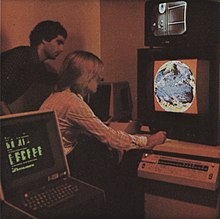| Company type | Private |
|---|---|
| Industry | Electronics |
| Founded | c. 1971; 53 years ago (1971) in Pasadena, California |
| Products | Digital image processors |
| Parent | 3M |
Comtal Corporation was an American electronics company that was one of the first to specialize in digital image processing. It was founded in the early 1970s and was acquired by 3M in 1980. Users of Comtal image processors included NASA, the military, computer-aided designers, X-ray technicians, and engineers in the field of signal processing.
History

Comtal Corporation was founded in the early 1970s in Pasadena, California. The foundation for the company's first products was based on research conducted on digital image processing by NASA in the 1960s at the Stennis Space Center (then known as the Mississippi Test Facility). This research yielded the Spectravision system, a digital image display manufactured by Aerojet in the late 1960s. Team members on the Spectragraph project founded Comtal in 1971 or 1972. Although a small operation, the company aggressively marketed its digital image displays through the mid-1970s, by which point Aerojet's Spectragraph system was extinct.
Comtal's first commercial product, the Comtal 5000 Series, was offered as a standalone desk console or a peripheral unit to a minicomputer. The 5000 Series comprised a specialized cathode-ray tube monitor and the processor, which could render 24-bit color at a resolution of 512×512, progressive scan. The 5000 Series was released in January 1974. Two months later, Comtal followed up with the 8000 Series, which offered the same color depth and resolution but increased the processing speed by 50 percent, improved the user interface, added the ability to switch from grayscale to color display on the fly, and enlarged the size of the display. In May 1974, the company unveiled the 8300 Series, which allowed the RGB channels to be imported and manipulated separately while adding the ability for a grayscale image to be rendered in false color. Comtal's 1977 Vision One system was dubbed by Business Screen magazine as "one of the most significant breakthroughs in the industry" due to its ability to load custom application software, negating the need for a mainframe or minicomputer. The Vision One offered either a charge-coupled device or 16-bit RAM as memory.
NASA employed Comtal's processors to process the first clear images from the surface of Mars as broadcast by the Viking program's space probes in 1976. NASA also used Comtal's processors to process transmissions of Jupiter by Voyager 2 in 1977. NASA previously commissioned Comtal in 1974 for the creation of the Portable Image Display Systems (PIDS)—an image processor designed for training geologists using sample Landsat satellite imagery as captured by MSS sensors—at the Stennis Space Center's Earth Resources Laboratory.
The company was acquired by 3M in 1980, after which it became known as 3M/Comtal, still based in Pasadena.
Notable alumni
- Peggy Cherng, technical engineer and software department manager from 1975–1982, later co-founder of Panda Express
Citations
- Staff writer 2013.
- ^ Staff writer 1977, p. S-21.
- ^ Staff writer 1993, p. 93.
- Patterson 1976, p. 21.
- Staff writer 1974a, p. 24.
- Staff writer 1974b, p. 39.
- Staff writer 1974c, p. 22.
- Whitley 1975, pp. 1356–1357.
- Barnfather 1982, p. 114; Lewell 1985, p. 69.
- Staff writer 2016.
References
- Barnfather, Maurice (March 1, 1982). "Can 3M Find Happiness in the 1980s?". Forbes: 113–116 – via Google Books.
- Lewell, John (1985). A–Z Guide to Computer Graphics. McGraw-Hill. ISBN 9780070374645 – via Google Books.
- Patterson, C. L. (June 1976). Survey of Digital Image Display Systems. Defense Technical Information Center – via the Internet Archive.
- Staff writer (February 1974). "Digital Image Display". SID Journal. 11 (1). Society for Information Display: 24 – via the Internet Archive.
- Staff writer (April 1974). "New Comtal Display". SID Journal. 11 (2). Society for Information Display: 39 – via the Internet Archive.
- Staff writer (August 1974). "Exhibits Seen". SID Journal. 11 (4). Society for Information Display: 22 – via the Internet Archive.
- Staff writer (March 1977). "Comtal Announces Stand Alone Image Processing System". Business Screen. Back Stage/Business Screen: S-21 – via the Internet Archive.
- Staff writer (1993). "Digital Image Processing". Spinoff. 992 (2). National Aeronautics and Space Administration: 93 – via Google Books.
- Staff writer (March 6, 2013). "30 Years Ago—1983". Machine Design. 85 (3). Penton Media: 28.
- Staff writer (September 2016). "How Did I Get Here?: Peggy Cherng". Bloomberg Businessweek. Bloomberg L.P. Archived from the original on September 22, 2016.
- Whitley, Sidney L. (June 1975). "Low-Cost Data Analysis Systems for Processing Multispectral Scanner Data". NASA Earth Resources Survey Symposium. I–B. National Aeronautics and Space Administration: 1355–1375 – via the Internet Archive.
- 1971 establishments in California
- 1980 mergers and acquisitions
- 3M
- Companies based in Pasadena, California
- Computer companies established in 1971
- Defunct computer companies based in California
- Defunct computer companies of the United States
- Defunct computer hardware companies
- Digital imaging
- 1980 disestablishments in California